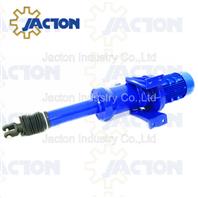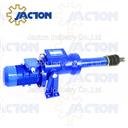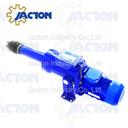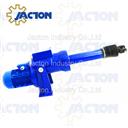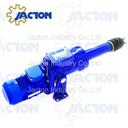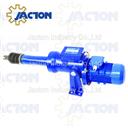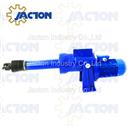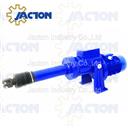Home» LA Electric Linear Actuators » Product Detail
Products
THE NAME:
300KG Inline Industrial Electromechanical Linear Actuator
Model: LA300
Categories: LA Electric Linear Actuators »
Place of Origin: Made In China
Brand Name: JACTON
Description:
Hydraulic vs. Electric Linear Actuator: Which is Best?
Electric linear actuators: Unlike the hydraulic variant, these linear actuators are powered exclusively by motors. The motor powers the lead screw, which is fitted with a nut that runs up and down the thread. This converts the rotary motion into linear movement.
Hydraulic linear actuators: These actuators are powered by pumps of incompressible oil. The pressure that the fluid creates moves the cylinders and, in turn, helps move your application.
300KG Inline Industrial Electromechanical Linear Actuator, Electric Rod Style Actuators Instead of Electro Hydraulic Linear Actuator and Pneumatic Cylinder. 300KG Inline Industrial Electromechanical Linear Actuator features include heavy load capacity, high linear speed, long service life, low noise system, no oil leaks, contamination or fire risk, accurate and repeatable positioning using simplified system, easy synchronization, easy installation, no pipework, powerpack and valves, choice of end fittings like clevis, threaded end, top plate, trunnion mounting (with or without feet), proximity switches, guided ram (guiding the load side loads on the actuator ram should be avoided by ensuring that the load is guided), and bellows boots. 300KG Inline Industrial Electromechanical Linear Actuator can not only match the load capacity of hydraulic cylinders and exceed the load capacity of conventional electric linear actuators. Main application in coiling machines, decoiling machines, continuous operation process lines, tundish cars, scissor lifts, lifting platforms, robotics, continuous paint pumps, medical beds, gates, dampers, oven and processing tank doors, antennas, and agricultural equipment.
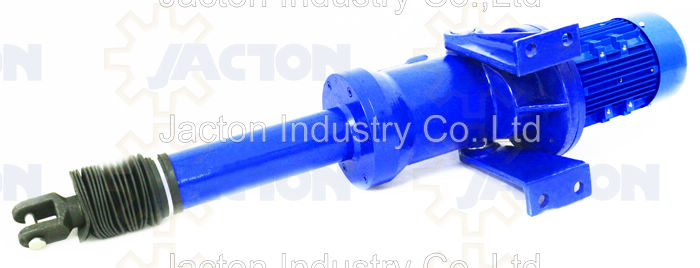
300KG Inline Industrial Electromechanical Linear Actuator Technical Details & Drawings

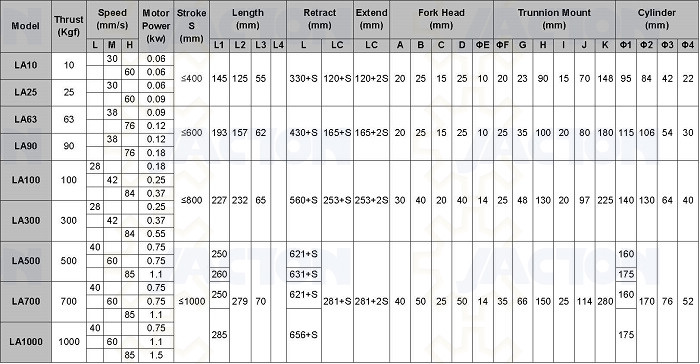
Trunnion Mounting Feet Drawings
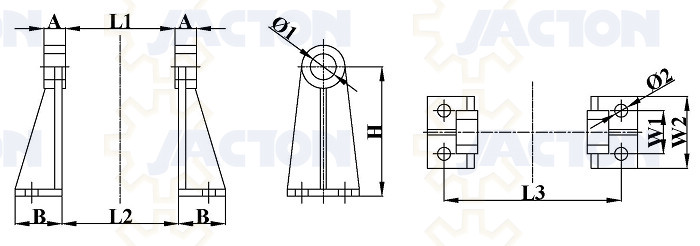
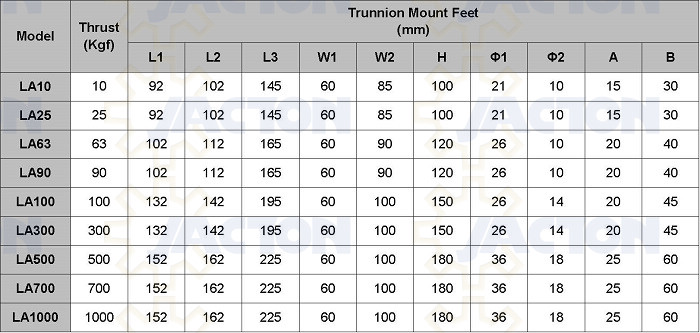
300KG Inline Industrial Electromechanical Linear Actuators are application in gates, dampers, oven and processing tank doors, antennas, orthopedic tables and other medical equipment, ergonomic furniture, and agricultural equipment, scissor lifts, scissor platforms, lifting platforms, robotics, continuous paint pumps, medical beds, coiling machines, tundish cars, continuous operation process lines opening and closing, tilting and pivoting, lifting and lowering, and positioning etc. Custom designs linear cylinders are also available for your special applications.
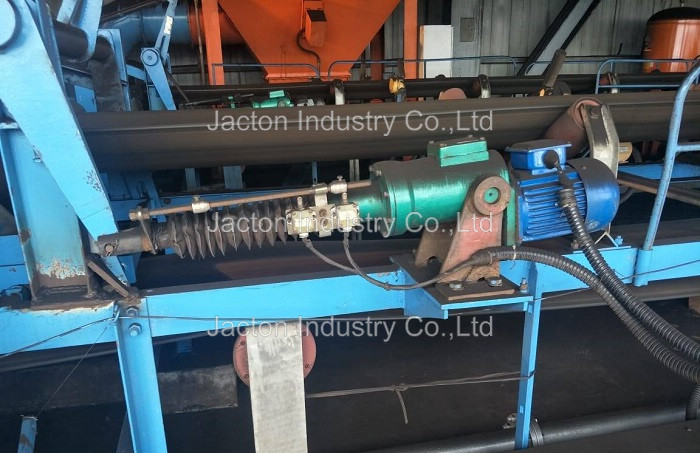
Electric linear actuators: Unlike the hydraulic variant, these linear actuators are powered exclusively by motors. The motor powers the lead screw, which is fitted with a nut that runs up and down the thread. This converts the rotary motion into linear movement.
Hydraulic linear actuators: These actuators are powered by pumps of incompressible oil. The pressure that the fluid creates moves the cylinders and, in turn, helps move your application.
300KG Inline Industrial Electromechanical Linear Actuator, Electric Rod Style Actuators Instead of Electro Hydraulic Linear Actuator and Pneumatic Cylinder. 300KG Inline Industrial Electromechanical Linear Actuator features include heavy load capacity, high linear speed, long service life, low noise system, no oil leaks, contamination or fire risk, accurate and repeatable positioning using simplified system, easy synchronization, easy installation, no pipework, powerpack and valves, choice of end fittings like clevis, threaded end, top plate, trunnion mounting (with or without feet), proximity switches, guided ram (guiding the load side loads on the actuator ram should be avoided by ensuring that the load is guided), and bellows boots. 300KG Inline Industrial Electromechanical Linear Actuator can not only match the load capacity of hydraulic cylinders and exceed the load capacity of conventional electric linear actuators. Main application in coiling machines, decoiling machines, continuous operation process lines, tundish cars, scissor lifts, lifting platforms, robotics, continuous paint pumps, medical beds, gates, dampers, oven and processing tank doors, antennas, and agricultural equipment.

300KG Inline Industrial Electromechanical Linear Actuator Technical Details & Drawings


Trunnion Mounting Feet Drawings


300KG Inline Industrial Electromechanical Linear Actuators are application in gates, dampers, oven and processing tank doors, antennas, orthopedic tables and other medical equipment, ergonomic furniture, and agricultural equipment, scissor lifts, scissor platforms, lifting platforms, robotics, continuous paint pumps, medical beds, coiling machines, tundish cars, continuous operation process lines opening and closing, tilting and pivoting, lifting and lowering, and positioning etc. Custom designs linear cylinders are also available for your special applications.

Previous Product:63KG In-line 700mm Stroke Electric Motor Linear Actuator
Next Product:500KG In-Line Electric Linear Actuator
Related Product
More products
Product List
Manual Electric Screw Jack
Worm Screw Jack
- JTC Cubic Screw Jack
- JTM Worm Screw Jack
- JSS Stainless Steel Jack
- JT Acme Screw Jack
- JTW Machine Screw Jack
- Through Holes Screw Jack
- Custom Made Screw Jack
Ball Screw Jack
Bevel Gear Jack
Miter Gearbox
- JT Classic Miter Gearbox
-
- Order Code for Classic Miter Gearbox
- Classic Miter Gearbox description
- JT15 Miter Gearbox
- JT19 Miter Gearbox
- JT25 Miter Gearbox
- JT32 Miter Gearbox
- JT40 Miter Gearbox
- JT45 Miter Gearbox
- JT50 Miter Gearbox
- JT60 Miter Gearbox
- JT72 Miter Gearbox
- JT85 Miter Gearbox
- Flange Input Solid Output Shaft Gearbox
- JTP Cubic Miter Gearbox
-
- Order Code for Cubic Miter Gearbox
- Cubic Miter Gearbox description
- JTP65 Small Miter Gearbox
- JTP90 Miter Gearbox
- JTP110 Miter Gearbox
- JTP140 Miter Gearbox
- JTP170 Miter Gearbox
- JTP210 Miter Gearbox
- JTP240 Miter Gearbox
- JTP280 Miter Gearbox
- Solid Input and Output Shafts Gearbox
- Solid Input and Hollow Output Gearbox
- Flange Input and Solid Output Gearbox
- Flange Input and Hollow Output Gearbox
- JTA Alu. Miter Gearbox
Lift System and Accessories
- Screw Jack System
- Lift System Accessories
-
- Flexible Jaw Coupling
- Overload Safety Couplings
- Aluminum Couplings
- Telescopic Universal Joint
- Rigid Shaft Couplings
- Universal Joint
- Cast Iron Hand Wheel
- Connecting Shafts
- Aluminum Handwheel
- YVF2 Series Variable Speed AC Motor
- Brake motors
- Three Phase Electric Motor
- Screw Jack Motor Flange
- Single Phase Induction Motors
- K Helical Bevel Geared Motor
- R Helical Geared Motor
- Worm Gear Reducer
- 12V 24V DC Geared Motor
- Proximity Switches
- Limit Switches
- Pillow Blocks
- Pillow Block Flange Bearing
- Digital Position Indicator
- Flange Blocks
- Ball Joint Rod End Bearing
- Bellows Boot
- Helical Gear Motor
- 12V 24V DC Motor
- Linear Bushings and Shafts
- Trunnion Adapters
- Servomotor
- Rotary Encoder
- Low Backlash Planetary Gearheads
- Stepper Motor
- 24V Planetary Gear Reducer
- Planetary Speed Reducer
- Frequency Inverter
- Hydraulic Cylinder Rod End Bearing
- Lift System Applications
Linear Actuators
- LAP Electric Linear Actuator
-
- 100KG Parallel Electromechanical Linear Actuators
- 250KG Parallel Electro Mechanical Linear Actuators
- 500KG Parallel Mount Rod Style Linear Actuators
- 630KG Parallel Mount Electric Cylinder Linear Actuators
- 1000KG Parallel Mount Industrial Linear Actuators Acme Screw
- 1600KG Parallel Electro-mechanical Actuators Heavy Duty
- 2500KG Parallel Mount Electric Cylinders Actuator
- 4000KG Heavy Duty Electric Linear Actuators Parallel Mount
- 6300KG Parallel Motor Drive Electric Actuator Linear Actuator
- 8000KG Parallel Electric Motor-Drive Linear Actuator
- 10000KG Parallel Mount Motorized Electric Linear Actuator
- 15000KG Parallel Industrial Motor Linear Actuator
- 20000KG Parallel Indistrial Motor Drive Linear Actuator
- 25000KG Parallel Electric Motor Linear Electric Actuator
- LA Electric Linear Actuators
-
- 10KG In-line Mini Electric Linear Actuators with Brake Motor
- 25KG In-line Electric Linear Actuator Push Rod
- 63KG In-line 700mm Stroke Electric Motor Linear Actuator
- 90KG In-line High Speed Motor Drive Electric Linear Actuator
- 100KG In-line Fast Speed Electric Linear Motor Linear Actuator
- 300KG Inline Industrial Electromechanical Linear Actuator
- 500KG In-Line Electric Linear Actuator
- 700KG Inline Heavy Electro Mechanical Actuators
- 1000KG In-line Heavy Duty AC Volt Industrial Linear Actuators
- JTE Classic Electric Cylinder
- Mechanical Linear Actuators
- JCA Cubic Electric Cylinder
Application
Jacton Industry Co.,Ltd.
 Contact: Warren Lee
Contact: Warren Lee
 Skype: jactonjack
Skype: jactonjack
 T: 86-769-81585810
T: 86-769-81585810
 F: 86-769-81585852
F: 86-769-81585852
 E: sales@jactonindustry.com
E: sales@jactonindustry.com
 W: www.screw-jack.com
W: www.screw-jack.com

 Contact: Warren Lee
Contact: Warren Lee Skype: jactonjack
Skype: jactonjack T: 86-769-81585810
T: 86-769-81585810  F: 86-769-81585852
F: 86-769-81585852  E: sales@jactonindustry.com
E: sales@jactonindustry.com  W: www.screw-jack.com
W: www.screw-jack.com 
VAT No. 9144190007026567X3, Copyright ©2013 www.screw-jack.com Jacton Industry Co.,Ltd. All Rights Reserved Site Map
Building 2, No. 1, DongCheng Road, Chang An, Dongguan, Guangdong, China. Phone: 86-769-81585810 | Fax: 86-769-81585852
China Screw Jack,Ball Screw Jack,Machine Screw Jack,Worm Gear Screw Jack,Bevel Gear Screw Jack,Miter Gearbox,Screw Jack Lift System Manufacturer
China Screw Jack,Ball Screw Jack,Machine Screw Jack,Worm Gear Screw Jack,Bevel Gear Screw Jack,Miter Gearbox,Screw Jack Lift System Manufacturer





